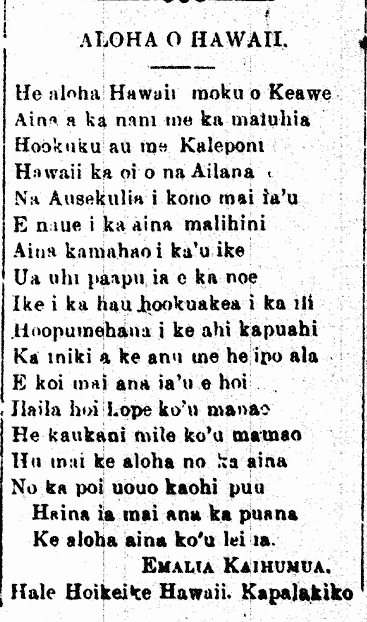Behold California, a Land of Cold.¹
J. U. Kawainui,
Aloha oe,
Here I am in California in good health. This is a very cold land, but there is always something new, there is no night here; the nights are like days.
These past few days, I have almost travelled all around the town; I went to visit the sugar refinery of the Millionaire², the place where they build warships, the place where money is minted, and the place where the soldiers drill (the Pressido [Presidio]).
I was at the Cliff House this past Thursday, it is a place that many visitors travel to, I saw the animals of the sea, but that place was very cold. After that, I went to the New City Hall and I spent almost a day visiting the various offices; it is a large structure perhaps eight times the size of Iolani Palace.
There are many poor people here with no place to sleep, and there are also many rich people.
PERTAINING TO THE GREAT EXHIBITION.
I went into the different exhibition halls of the Fair, so astonishing to see; there were all kinds of beautiful things.
I was in Alameda County, a large building, and within it, there was every variety of fruit.
Arizona Indian Building is the exhibition hall of the Indians [Ilikini]. There I saw their way of dancing; their dress is fine, but their dancing isn’t great.
I went into the building of hand crafts and saw the making of the clothes that we wear and so forth, and the exhibition hall of all kinds of animals. This week, one of the handlers was killed, mauled by a lion; the reason for this was the the lights went out when the handler was sweeping inside, at which point it jumped and tore at him. I saw the blood and the suit which is placed out as a display in the pen; today there was a service over his dead body. All the people in the fair attended the funeral, the Hawaiian youths sang in Hawaiian, “In Jesus’ Hands” [“Ma ko Iesu mau lima.”] .
The most highly attended thing is the display of Kilauea in Hawaii; the haole men and women are very taken by Hawaiian things, but above all is the hula kui; all the time is filled with hula kui.
There are two bands constantly playing in the Park, but they aren’t good like the Hawaiian boys; I am always being asked by many people if I will be attending the college that John Wilson³ is attending; I have a letter urging me to go there (Stanford University).
James B. Pakele.
San Francisco, February 17, 1894.
¹”Ike ia Kaleponi he Aina Anu” hearkens back to the mele “E Nihi ka Hele”.
²Spreckels Sugar Company of Claus Spreckels, known here as the Ona Miliona [Millionaire].
³See more on John Henry Wilson in Men of Hawaii.
[For related articles and information, see the previous posts, and the posts soon to come as well! Oh… and coincidentally, i noticed i recently posted James B. Pakele’s death announcement from 1913. He died at Queen’s Hospital on January 30.]
(Kuokoa, 3/3/1894, p. 1)

Ka Nupepa Kuokoa, Buke XXXIII, Helu 9, Aoao 1. Maraki 3, 1894.






